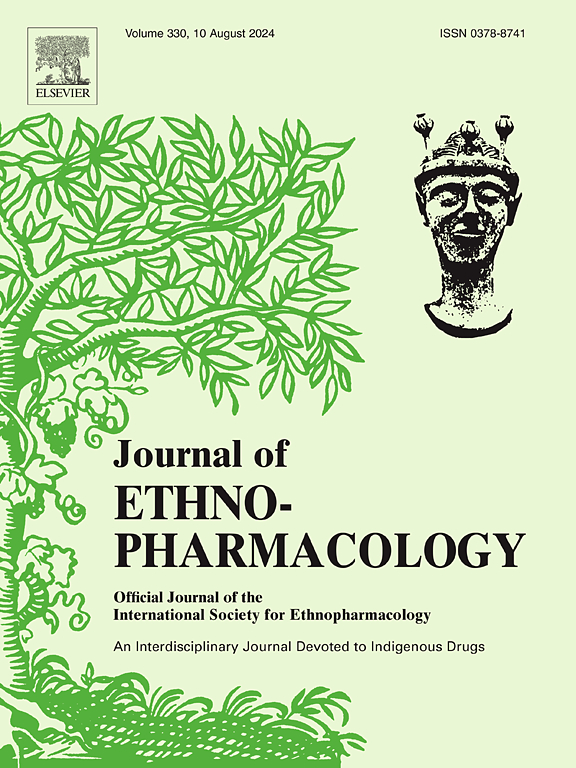Kouqiangjie formula alleviates diabetic periodontitis by regulating alveolar bone homeostasis via miR-29a-3p-mediated Dkk-1/Wnt/β-catenin signaling pathway
IF 4.8
2区 医学
Q1 CHEMISTRY, MEDICINAL
引用次数: 0
Abstract
Ethnopharmacological relevance
Diabetic periodontitis (DP) is a commonly co-occurring complication in diabetes patients characterized by advanced gum disease and bone resorption. Conventional treatment modalities often fail to adequately address the underlying biological disruptions caused by diabetes. The use of traditional medicinal formulas Kouqiangjie Formula (KQJF) potentially offers novel therapeutic approaches for DP, but its detailed regulatory mechanisms remain unclear.
Aim of the study
This study aims to investigate the impacts of KQJF on osteoblastic activity and inflammatory responses in a rat model and in vitro pre-osteoblast cultures under conditions mimicking DP, focusing on the involvement of the miR-29a-3p-Dkk-1/Wnt/β-catenin signaling pathway.
Materials and methods
Using network pharmacological analysis, micro-CT, histological staining, and an array of molecular biology methodologies including Western blotting, RT-qPCR, and immunofluorescence, we investigated the systemic and cellular responses to KQJF treatment. Both in vivo (rat model) and in vitro (MC3T3-E1 pre-osteoblasts) models subjected to high glucose and lipopolysaccharide (HG + LPS) stress were used to simulate DP conditions.
Results
Network pharmacological analyses, incorporating protein-protein interactions and pathway enrichment, disclosed that KQJF interacts with pathways crucial for inflammation and bone metabolism. Experimentally, KQJF significantly preserved alveolar bone architecture, reduced osteoclast activity, and dampened inflammatory cytokine production in DP rats. In pre-osteoblasts, KQJF enhanced cell viability, promoted cell cycle progression, and decreased apoptosis. At the molecular level, KQJF treatment upregulated miR-29a-3p and downregulated Dkk-1, thereby activating the Wnt/β-catenin pathway. The interventional studies with miR-29a-3p antagonists and Dkk-1 knockdown further confirmed the regulatory role of the miR-29a-3p/Dkk-1 axis in mediating the effects of KQJF.
Conclusion
KQJF mitigates the deleterious effects of DP by enhancing osteoblastic activity and reducing inflammatory responses, predominantly through the modulation of the miR-29a-3p-Dkk-1/Wnt/β-catenin signaling pathway. These discoveries underscore the therapeutic promise of KQJF in managing bone and inflammatory complications of DP, offering insights into its mechanism, and supporting its use in clinical settings.

口强结方通过mir -29a-3p介导的Dkk-1/Wnt/β-catenin信号通路调节牙槽骨稳态,缓解糖尿病牙周炎。
民族药理学相关性:糖尿病牙周炎(DP)是糖尿病患者以晚期牙龈疾病和骨吸收为特征的常见并发症。传统的治疗方式往往不能充分解决糖尿病引起的潜在生物破坏。传统中药方口强结方(KQJF)的使用可能为DP提供新的治疗方法,但其具体的调控机制尚不清楚。研究目的:本研究旨在探讨KQJF在模拟DP的大鼠模型和体外成骨前培养中对成骨细胞活性和炎症反应的影响,重点关注miR-29a-3p-Dkk-1/Wnt/β-catenin信号通路的参与。材料和方法:利用网络药理学分析、显微ct、组织学染色和一系列分子生物学方法,包括Western blotting、RT-qPCR和免疫荧光,我们研究了KQJF治疗后的全身和细胞反应。采用体内(大鼠模型)和体外(MC3T3-E1前成骨细胞)模型模拟高糖和脂多糖(HG+LPS)应激的DP条件。结果:网络药理学分析,结合蛋白-蛋白相互作用和途径富集,揭示了KQJF与炎症和骨代谢的关键途径相互作用。在实验中,KQJF可显著保护DP大鼠的牙槽骨结构,降低破骨细胞活性,并抑制炎症细胞因子的产生。在成骨前细胞中,KQJF增强细胞活力,促进细胞周期进展,减少细胞凋亡。在分子水平上,KQJF处理上调了miR-29a-3p,下调了dk1 -1,从而激活了Wnt/β-catenin通路。miR-29a-3p拮抗剂和Dkk-1敲低的介入研究进一步证实了miR-29a-3p/Dkk-1轴在介导KQJF作用中的调节作用。结论:KQJF通过增强成骨细胞活性和减少炎症反应来减轻DP的有害影响,主要是通过调节miR-29a-3p-Dkk-1/Wnt/β-catenin信号通路。这些发现强调了KQJF在治疗DP的骨和炎症并发症方面的治疗前景,提供了对其机制的见解,并支持其在临床环境中的应用。
本文章由计算机程序翻译,如有差异,请以英文原文为准。
求助全文
约1分钟内获得全文
求助全文
来源期刊

Journal of ethnopharmacology
医学-全科医学与补充医学
CiteScore
10.30
自引率
5.60%
发文量
967
审稿时长
77 days
期刊介绍:
The Journal of Ethnopharmacology is dedicated to the exchange of information and understandings about people''s use of plants, fungi, animals, microorganisms and minerals and their biological and pharmacological effects based on the principles established through international conventions. Early people confronted with illness and disease, discovered a wealth of useful therapeutic agents in the plant and animal kingdoms. The empirical knowledge of these medicinal substances and their toxic potential was passed on by oral tradition and sometimes recorded in herbals and other texts on materia medica. Many valuable drugs of today (e.g., atropine, ephedrine, tubocurarine, digoxin, reserpine) came into use through the study of indigenous remedies. Chemists continue to use plant-derived drugs (e.g., morphine, taxol, physostigmine, quinidine, emetine) as prototypes in their attempts to develop more effective and less toxic medicinals.
 求助内容:
求助内容: 应助结果提醒方式:
应助结果提醒方式:


